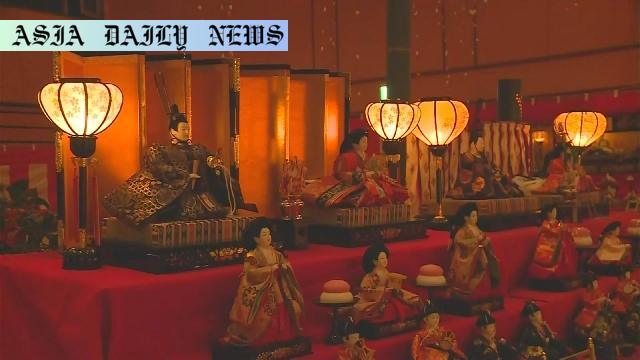Hina Dolls: Traditional ‘Hina’ folk dolls light up under lanterns in Okayama’s annual exhibition, showcasing cultural heritage.
- Hina Dolls illuminated under lanterns for the Girls’ Festival in Okayama, Japan.
- Exhibition showcases 1,500 dolls, including rare Miyoshi clay dolls dating back to the Meiji Period.
- The event celebrates a cultural tradition with families and organizers collecting dolls from the community.

Introduction to the Hina Dolls Tradition
The enchanting tradition of displaying “Hina” dolls holds a special place in Japan’s cultural heritage. These intricately designed folk dolls are cherished and passed down through generations, celebrated annually as part of the Girls’ Festival, also known as Hinamatsuri. Held on March 3, the festival is a day of happiness and recognition for girls and young women, marked by vibrant exhibitions of dolls that offer a glimpse into Japan’s rich history of artisan craftsmanship.
Highlights of the 2023 Hina Exhibition
This year’s exhibition in Niimi City, Okayama Prefecture, beautifully showcased this tradition through a breathtaking display of over 1,500 Hina dolls. Held on a serene Sunday night under the glow of lanterns, visitors experienced a captivating atmosphere infused with history and artistry. Among the displayed dolls were 450 rare Miyoshi clay dolls, a unique variety locally crafted in neighboring Hiroshima Prefecture’s Miyoshi City. These handcrafted dolls symbolize the preservation of local heritage and craftsmanship that dates back to the Meiji Period, from the 19th to early 20th centuries.
The Cultural Legacy of Miyoshi Dolls
Miyoshi clay dolls boast a distinctive artistry, reflecting the traditional aesthetics of the region. Each doll is created through a meticulous process passed down generations. Yoshihara Yasuko, the event’s organizer, emphasized that these dolls were once present in every household in the region. Gathering such a vast collection from local residents highlights the community’s deep-rooted cultural pride and commitment to preserving these tangible pieces of history.
An Event for Families and Heritage
The event is not merely a grand display but also a moment for families to create lasting memories. One mother in attendance shared her fond memories of owning Hina dolls as a child and expressed her desire to continue the Girls’ Festival tradition with her children. The exhibition thus serves as a bridge between past and present, allowing younger generations to partake in the essence of their heritage.
The Significance of Lanterns and Setting
The use of “bonbori” paper lanterns and bamboo lanterns added a dreamlike quality to the night exhibition. The soft ambient lighting accentuated the intricate features of the dolls, creating an immersive and poetic atmosphere. The interplay between light and shadow brought the dolls’ details to life, mesmerizing visitors with its tranquil beauty.
Preserving Tradition for Future Generations
The annual Hina exhibition emphasizes the importance of sustaining cultural traditions in a rapidly modernizing world. By bringing together community members to contribute their Hina dolls, the event fosters unity and collective appreciation of shared heritage. It underscores how traditions evolve yet remain steadfast, nurturing cultural identity for future generations to cherish and uphold.
Conclusion
Through its stunning display of over 1,500 Hina dolls, the Niimi City event transcends being merely an exhibition. It is a celebration of artistry, family values, and community spirit that resonates deeply with everyone in attendance. As visitors revel in the timeless charm of these dolls under the serene lantern light, they carry forward a rich legacy that connects them to history while inspiring future celebrations of Japanese culture.



Commentary
Symbolism of Hina Dolls in Japanese Culture
The Hina dolls’ tradition is an elegant reminder of how strongly Japan values its cultural identity. It’s fascinating to consider how these intricate dolls transcend mere decoration to embody the hopes and dreams of families for their daughters’ happiness, health, and success. Observing how the community of Niimi City comes together to celebrate this heritage demonstrates a profound respect for tradition, something we could all learn from.
A Testament to Community and Unity
One of the most heartwarming aspects of the Hina exhibition is the collaboration required to bring it to life. Hundreds of families contributed their cherished dolls for public display, proving that heritage is a shared responsibility. It’s not just about artistry but also about building connections across generations, enabling these traditions to thrive in a modernizing world. This sense of unity and cooperation showcases the true essence of community living.
Relevance of Tradition in a Modern World
In a fast-paced, globalized society, events like this remind us of the importance of pausing to cherish our roots. The Hina dolls not only celebrate an ancient tradition but also inspire future generations to understand where they come from. By connecting the past with the present, exhibitions like these become bridges that give younger people a sense of belonging and pride in their cultural origins.
Final Reflections
Overall, the annual Hina exhibition in Niimi is not just an event; it’s an experience that offers people an opportunity to connect with their history, family, and community. The meticulously crafted dolls, enchanting lantern light, and heartfelt community participation make it a truly magical event, worth aspiring to witness. It’s a firm reminder that preserving tradition is not about looking backward but about keeping the beauty of the past alive in the present.